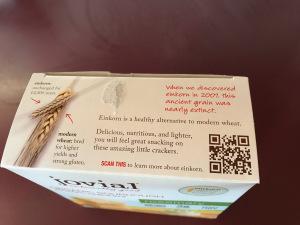Back when I was somebody—a professor is somebody, even if only a seminary professor—I was invited to meet with a group of Seattle writers and intellectuals.I was in Seattle already because driving all the way out here was possible when you live in the Midwest and your summers are basically open and free.(Professor’s privilege.)One of the group members, the one who invited me, asked me about grain.When the club met they ate.With a bent toward history, one of them brought period-appropriate bread.What kind would be fashionable for a night of ancient Near East talk?(I was still researching and writing on Ugarit at the time, before Ugaritology passed away.)Without stopping to think I replied “Einkorn.”I didn’t know if einkorn was still around or not.All I knew is that it was the earliest (at least as understood at that time) domesticated grain.The loaf that arrived that night was a more accessible grain variety.
All of this came back to me as I stood in the local health-food store.We don’t shop here for regular groceries—it’s expensive to eat healthily—but we’d been invited to someone’s house and said we’d bring appetizers.The health-food store had vegan cheeses, so we needed crackers to go with.Then I spied the word “einkorn.”The Seattle discussion had to be well onto two decades old by now.I was finally able to answer my question, einkorn was still alive.The craze for ancient grains did not exist in my professorate days.Some companies, according to occasional news stories, were trying to brew the beer of ancient Egypt or Sumer, but the health conscious hadn’t gone so far as to trying to replicate the diet of the earliest agriculturalists.

Ancient grains cost more because the yields are smaller.Although the grain heads look disturbingly like those house centipedes that scamper in the basement when you flip on the light, they aren’t nearly the size of a current wheat head.It stands to reason that it takes more of them to make up the same amount of flour, and appetites have grown over the millennia.Like most vegans, I read boxes.Another ancient grain cracker, apart from brown rice, included amaranth, flaxseed, millet, quinoa, sesame, and sorghum.Never mixed this way in antiquity (for amaranth and quinoa were part of the “new world” and the others “old”), modern mixologists have devised new ways of using ancient grains.Einkorn nearly went extinct with the development of wheat, rye, and barley.But it hung on, and now, as a dozen millennia ago, it has a way of sustaining both dreams and fantasies.
